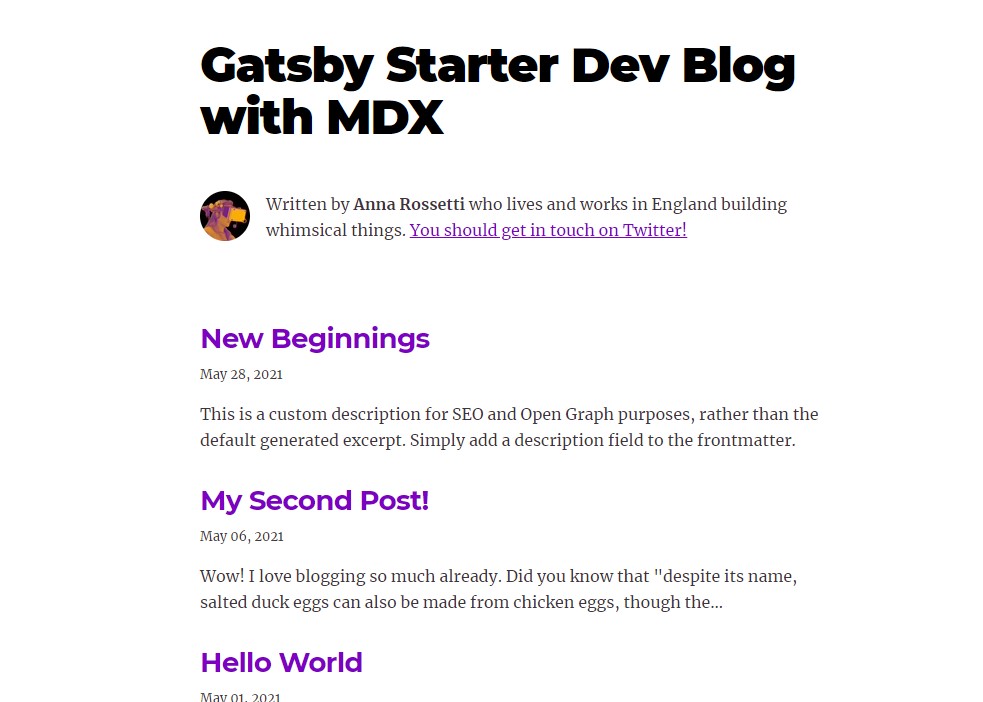Gatsby V3 Starter Blog for Devs, with MDX and Custom Code Blocks
Description
This is a GatsbyJS V3 starter forked form the official gatsby-starter-blog, with the addition of MDX support and custom code blocks, including code block title, ‘Copy’ button and language ribbon.
Demo
You can see a working demo here.

Prerequisites
Make sure you have Node.js at version 12 or higher installed, as well as Git and Gatsby Cli. If you don’t already have Gatsby Cli installed, do that first.
npm install -g gatsby-cli🚀 Quick start
-
Create a Gatsby site.
Use the Gatsby CLI to create a new site, specifying the blog starter.
# create a new Gatsby site using the blog starter gatsby new my-blog-starter https://github.com/gatsbyjs/gatsby-starter-blog -
Start developing.
Navigate into your new site’s directory and start it up.
cd my-blog-starter/ gatsby develop -
Open the source code and start editing!
Your site is now running at
http://localhost:8000!Note: You’ll also see a second link:
http://localhost:8000/___graphql. This is a tool you can use to experiment with querying your data. Learn more about using this tool in the Gatsby tutorial.Open the
my-blog-starterdirectory in your code editor of choice and editsrc/pages/index.js. Save your changes and the browser will update in real time!
🧐 What’s inside?
A quick look at the top-level files and directories you’ll see in a Gatsby project.
. ├── node_modules ├── src ├── .gitignore ├── .prettierrc ├── gatsby-browser.js ├── gatsby-config.js ├── gatsby-node.js ├── gatsby-ssr.js ├── LICENSE ├── package-lock.json ├── package.json └── README.md
-
/node_modules: This directory contains all of the modules of code that your project depends on (npm packages) are automatically installed. -
/src: This directory will contain all of the code related to what you will see on the front-end of your site (what you see in the browser) such as your site header or a page template.srcis a convention for “source code”. -
.gitignore: This file tells git which files it should not track / not maintain a version history for. -
.prettierrc: This is a configuration file for Prettier. Prettier is a tool to help keep the formatting of your code consistent. -
gatsby-browser.js: This file is where Gatsby expects to find any usage of the Gatsby browser APIs (if any). These allow customization/extension of default Gatsby settings affecting the browser. -
gatsby-config.js: This is the main configuration file for a Gatsby site. This is where you can specify information about your site (metadata) like the site title and description, which Gatsby plugins you’d like to include, etc. (Check out the config docs for more detail). -
gatsby-node.js: This file is where Gatsby expects to find any usage of the Gatsby Node APIs (if any). These allow customization/extension of default Gatsby settings affecting pieces of the site build process. -
gatsby-ssr.js: This file is where Gatsby expects to find any usage of the Gatsby server-side rendering APIs (if any). These allow customization of default Gatsby settings affecting server-side rendering. -
LICENSE: This Gatsby starter is licensed under the 0BSD license. This means that you can see this file as a placeholder and replace it with your own license. -
package-lock.json(Seepackage.jsonbelow, first). This is an automatically generated file based on the exact versions of your npm dependencies that were installed for your project. (You won’t change this file directly). -
package.json: A manifest file for Node.js projects, which includes things like metadata (the project’s name, author, etc). This manifest is how npm knows which packages to install for your project. -
README.md: A text file containing useful reference information about your project.
🎓 Learning Gatsby
Looking for more guidance? Full documentation for Gatsby lives on the website. Here are some places to start:
-
For most developers, we recommend starting with our in-depth tutorial for creating a site with Gatsby. It starts with zero assumptions about your level of ability and walks through every step of the process.
-
To dive straight into code samples, head to our documentation. In particular, check out the Guides, API Reference, and Advanced Tutorials sections in the sidebar.
🦄 Customize
Open up the gatsby-config.js file in the root folder and find the site metadata information. Replace author bio information with your own: change the title of the site, the author name and summary, your site’s description and your twitter handle. Change your URL as well if you already have one.
siteMetadata: {
title: `Your Site Title`,
author: {
name:`Your Name`,
summary: `who lives and works in New York City building whimsical things.`,
},
description: `A starter blog demonstrating what Gatsby and MDX can do.`,
siteUrl: `https://gatsbystarterblogsource.gatsbyjs.io/`,
social: {
twitter: `your_twitter_handle`,
},
},If you want to use Google Analytics to track your site’s stats, look for the following lines, uncomment them and add your own tracker:
// {
// resolve: `gatsby-plugin-google-analytics`,
// options: {
// trackingId: `ADD YOUR TRACKING ID HERE`,
// },
// },Open the src > images folder and replace the profile-pic.jpg file with your own profile picture. Optionally, replace the gatsby-icon.png file with your own site favicon.
Finally, open the content/blog folder and edit your posts. To add a new post, create a new folder inside content/blog and add a new index.mdx file inside.
💫 Deploy
Build, Deploy, and Host On Gatsby Cloud:
Check out other hosting options and Gatsby deployment guides in the official docs.
Acknowledgements
This project is bootstrapped using Gatsby’s gatsby-starter-blog template, originally by Kyle Mathews. Chris Biscardi has written a wealth of information on integrating MDX in Gatsby sites. I found Jim Raptis’ article on adding a ‘Copy Code’ button to a Gatsby blog particularly useful. If using Gatsby V2, Matt Hagner’s gatsby-starter-blog-mdx is a great resource.


